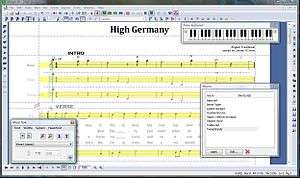Mozart the music processor
|
| |
 | |
| Original author(s) | David Webber |
|---|---|
| Initial release | 9 November 1994 |
| Stable release | 13.0.10[1][2] (6 May 2016) [±] |
| Development status | Active |
| Operating system | MS Windows XP/Vista/7/8 |
| Available in | EN, CS, CY, DE, ES, FR, IT, NL, SV, ZH |
| Type | Scorewriter |
| License | Commercial |
| Website | www.mozart.co.uk |
Mozart the music processor is a proprietary WYSIWYG scorewriter, written by David Webber. It enables computers using Microsoft Windows to produce musical notation and listen to them in MIDI.
History
Mozart started as a personal project to assist the author in arranging music for the groups in which he played. Version 1 was released on 9 November 1994. A new major version is released about every 18 months. Intermediate service packs are issued as needed.
Features
- Score entry by computer keyboard, mouse, on-screen piano keyboard, external MIDI instrument
- Large library of predefined templates
- Support for a large collection of transposing instruments
- Large library of stringed instruments for chords
- Support for a large number of plucked string instruments (i.a. banjo, ukulele, tamburitza) in various tunings
- Score can be shown in concert pitch, written pitch, B♭ pitch
- Optional courtesy accidentals
- Key signature change with optional cancelling naturals
- Free application of enharmonic equivalents (
 , ♭, ♮, ♯,
, ♭, ♮, ♯,  )
) - Transposable guitar chords
- Use of third party music symbol fonts, e.g. NorMusic JazzFont
- All text items support Unicode characters
- Keyboard shortcuts for accented characters and symbols
- Customisable mapping of keyboard shortcuts
- Programmable through macros
- Import MusicXML, NIFF,[3] MIDI (.MID, .RMI, .KAR)
- MIDI export
- Multi-language (currently EN, CS, CY, DE, ES, FR, IT, NL, SV, ZH), including support for languages with irregular plurals, e.g. in Welsh or Czech; the names of notes also in DE
- Part extraction
- Lyrics attached to notes
- Text boxes
- Extensive, context-sensitive Help system
- Playback, optionally with tracking cursor
- Playback follows repeats and redirections
- Playback obeys dynamics, pedal marks, phrasing, rubato, and articulation including tremolo and reiteration
- Optional automatic right justification
- Cross- and diamond-shaped note heads, cue notes
- Tablature notation for guitars and lutes
- Copy bitmaps to the Windows clipboard
- Gold-certified to run under Wine-1.1.36 on Slackware Linux 12.1[4]
- Support for foot pedal page turners
Shortcomings
- Limited control over MIDI events
- Score must have a time signature, common to all parallel staves
- Key signatures are restricted to 7 accidentals; no F-flat major/D-flat minor or G-sharp major/E-sharp minor
- No Gregorian chant notation
- No quarter tone notation
See also
References
- ↑ Service Pack for Mozart 13
- ↑ Bugfix Mozart 13
- ↑ NIFF – History, features, programs supporting NIFF
- ↑ Toal, Lawrence (21 January 2010). "WineHQ – Mozart the Music Processor Mozart 10". Wine HQ. Retrieved 26 January 2010.
External links
This article is issued from Wikipedia - version of the 6/26/2016. The text is available under the Creative Commons Attribution/Share Alike but additional terms may apply for the media files.